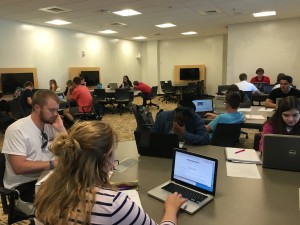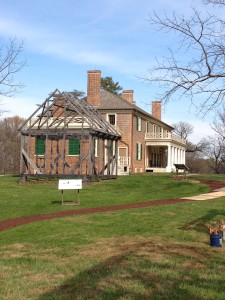About three years ago, I recreated my own domain. I had had a fairly extensive website back in the late 1990s, when Web 1.0 ruled the universe, but when I came to JMU in 2005, I found that faculty overwhelmingly used Blackboard and hid their syllabi and assorted pedagogical aids away from public sight. It has been interesting to watch the shift toward open ed occurring here in the last decade. As more and more faculty, generally the younger ones, experimented more and more with WordPress and Omeka and similar tools, I did, too. And as I added blogging assignments, digital exhibits, and web-based portfolios to my classes, I realized that it was high time to put my own self out there again. How could I ask my students to create their own domains and post their own work under their own names if I was not willing to do the same thing myself?
I admit that I’m still anxious about the kinds of privacy and surveillance issues that Audrey Watters raises in her recent keynote, Ed-tech in a Time of Trump, but that anxiety is now part of my approach to open pedagogy, which I understand to be a real thing, after all:
I love that you’re like ‘I didn’t know there was a name for it.’ There is a name for it, as soon as I pretend there’s a name for it. Open Ped is kind of in a phase where it’s becoming a thing, but it may or may not actually be a thing. I don’t know when you get to say something is a thing. Robin DeRosa
In my Introduction to Public History, students create their own web domains as their semester-long project. I have an undergraduate working with me, Edel Rimando, who is serving this semester as a fellow in the Digital Communication (DigiComm) Center. It’s a sweet deal: she is an effective peer mentor, since she is one of them, and she holds her own consultation hours in addition to leading three (three!) hands’ on workshops in class. The first time I assigned students to create websites I required them to use WordPress, which is my preferred platform, however, I was not comfortable enough with the myriad options to be an effective guide. The second time, I allowed them to choose between WordPress and Wix and Weebly, the drag-and-drop options that DigiComm recommends to first-timers. All of the students in that class chose Wix or Weebly, so this semester, that is what we (Edel and I) went with. I don’t use them and I don’t like them for all the reasons DeRosa notes in her interview, but they are user-friendly, efficient, and get the job done.
The students have freedom to design their domains as they want. We discussed professional designs, branding, and so forth. We also discussed some basic ways to protect privacy. Each person has to have a simple resume and a biographical statement that explains what the site’s function will be. Is it merely to fulfill this class’s requirement or will he or she use it to curate excellent work from multiple classes? Many of my students are public history concentrators, so they have required internships for which they have to create a blog, which they can link to their domain. Other students are in the teaching licensure program and create links to lesson plans they have made, while others still are in graphic design and use their domains to showcase their commercial work. I have been amazed at the range of talents and projects that my students showcase on their domains–from photography to music videos to traditional research papers.
To meet the outcomes for public history the students must include two projects specific to this class’s content. The first is an analysis of a city block in downtown Harrisonburg; each student is assigned a section of an historic fire insurance map that documents how a block appeared ca 1960 and then she has to physically walk the block today paying attention to and interpreting changes in the cultural landscape from then to now. Although the students initially produce traditional written essays, they are actually generating content for their individual domains. Transforming that essay, with its written text and digital maps and photographs, into a webpage poses an interesting and instructive challenge that fits the open pedagogy model in the way it employs a learner-driven process and connects to the wider public. The assignment asks them to consider writing for a public audience instead of me, their professor, and to play with design and navigability among other things. By putting their work online they are clearly doing a kind of public history, although they understand that they are not doing digital public history in the sense of inviting the public to participate in the project or comment on their work. The project does not, in other words, involve the community itself, and I can only say “next time” to that criticism.
A second project that they must complete offers a different challenge. It involves a field trip to Montpelier, the home of James and Dolley Madision, which serves as a case study for many of the different branches of public history we study: historic preservation, historic house museums, exhibit design, virtual tourism,, archaeology. In effect, they choose a particular aspect of public history that appeals to them and they use their visit as an opportunity to explore how that aspect works at an actual historic site. Of course, they must then figure out to present their analyses on their domains. Although they have examples and a rubric, I try not to direct them too much. They need to feel ownership and have agency for the assignment to succeed.
As they build their sites they work with their fellow classmates, not just me and Edel. I requested and got approval to teach in one of JMU’s EPIC classrooms, which has six tables or pods seating six students each. During the regular class meetings, students plug their laptops into the various outlets and take turns projecting their screens to a wall-mounted monitor. As they work through in-class digital exercises and discuss readings, they have been building a sense of community that will serve them in good stead when they present their domains in the final weeks of class. These days have been scheduled well in advance and serve as design charettes. Each student’s URL will be added to a common Google doc so that the entire audience can navigate along with the presenter and provide feedback to be used prior to final submission for grading.
This assignment, well, this entire class isn’t nearly as open as it could be or I’d like it to be. In other classes I have experimented with different open pedagogical practices, baby-stepping my way toward something more radical. I appreciated reading about Robin DeRosa’s extreme makeover: pedagogy edition and seeing her candid acknowledgement of the time it takes to build your network of outsiders who are willing to participate in the students’ open learning experience. I also found it helpful to think about the tension between content transfer and skill development in many courses, especially upper-level ones in the major, as mine is. Content transfer has definitely taken a back seat to community building and students’ self-efficacy. My role is that of facilitator, and despite my worries about the risks (privacy, surveillance, trolls) associated with open learning, I find the whole open pedagogy thing energizing.


